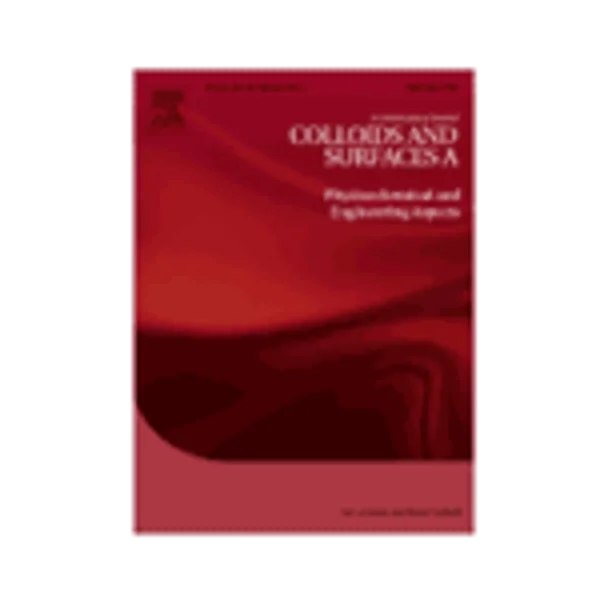-
role of non-covalent interactions in the molecular organization of n-n-hexadecanoyl amino acid amphiphiles with hydrophobic c
جزئیات بیشتر مقاله- تاریخ ارائه: 1392/07/24
- تاریخ انتشار در تی پی بین: 1392/07/24
- تعداد بازدید: 936
- تعداد پرسش و پاسخ ها: 0
- شماره تماس دبیرخانه رویداد: -
role of non-covalent interactions on the molecular packing of n-n-hexadecanoyl amino acid amphiphiles (nhaa) has been studied using a set of corresponding l-amino acid (glycine, alanine, valine, proline and phenylalanine) derivatives in 50 mm tris buffer at ph 9.3. self-assembly properties in aqueous dispersion were characterized by various physical techniques like tensiometry, fluorimetry, uv–vis spectroscopy, circular dichroism (cd) and differential scanning calorimetry (dsc). the results reveal that the hydrophobic interaction plays the driving role for such self assembly phenomena which is synergistically influenced by additional non-covalent interactions among the surfactants arising from the amino acid units present on the molecular backbone. despite major similarities in structural elements (except their cα-side chain residues) among all the nhaa amphiphiles described here, three issues were found to be important towards their self assembly properties viz, (a) optimal intermolecular distance that arises from van der waals repulsions of the side chain residues and the electrostatic repulsions among anionic head groups; (b) intermolecular h-bonding and π–π type attractive interaction that reduces the intermolecular distance and (c) the effective solvation of the head groups required for the self assembly. since, primary amide group is ubiquitous for all the amphiphiles except nhpro, the strength of h-bonding interaction among the amphiphiles was also investigated and found to be affected by the nature of the cα-side chain residues. nhphe was found to be unique compared to others due to the π–π type attractive interaction operative at the aromatic cα-side chain while for others, the repulsive interactions among the cα-side chain residues make them behave differently. optimized non-covalent interactions with requisite solvation of the head group, molecular packing was found to be better for nhala, while such packing was affected by van der waals repulsion among the bulky cαsubstituents (e.g. isopropyl group for nhval) or stabilized by π–π interaction (for nhphe) and intermolecular h-bonding interaction via amide linkages. the self-assembly behavior was found to be complex for proline based system (nhpro) where the hydrophobic effect and the steric disposition of the cyclic side chain significantly influence its molecular packing as well as its other self assembly properties. the characterization of thermodynamic parameters reveals that the hydrophobicity of cα-substituents lowers the free energy of micellization. the dsc studies show that krafft temperature and enthalpy of solution were affected by the nature of the cα-substituents. the van der waals repulsion among the bulky substituents increases the intermolecular separation reducing the strength of the molecular packing as well as the aggregation number. an invariant cd signature for nhphe at its non aggregated and aggregated state indicates a unique non-chiral self assembly and a new π–π dimeric molecular organization model for nhphe amphiphiles has been proposed to rationalize this behavior.
مقالات جدیدترین رویدادها
-
استفاده از تحلیل اهمیت-عملکرد در ارائه الگوی مدیریت خلاقیت سازمانی و ارائه راهکار جهت بهبود
-
بررسی تاثیر ارزش وجوه نقد مازاد بر ساختار سرمایه شرکت های پذیرفته شده در بورس اوراق بهادار تهران
-
بررسی تأثیر سطح افشای ریسک بر قرارداد بدهی شرکت های پذیرفته شده در بورس اوراق بهادار تهران
-
بررسی تأثیر رتبه بندی اعتباری مبتنی بر مدل امتیاز بازار نوظهور بر نقد شوندگی سهام با تأکید بر خصوصی سازی شرکت ها
-
تأثیر آمیخته بازاریابی پوشاک ایرانی بر تصویر ذهنی مشتری پوشاک ایرانی (هاکوپیان)
-
تاثیر حمایت اجتماعی بر قصد خرید با نقش میانجی اعتماد و تبلیغات شفاهی الکترونیکی
-
طراحی بنای میان افزا به روش زمینه گرایی در بافت تاریخی (نمونه مطالعاتی بافت جلفای اصفهان)
-
ارزیابی خصوصیات ژئوتکنیکی خاک های مناطق شرقی دشت مشهد (مطالعه موردی، پروژه تصفیه خانه فاضلاب شماره 4 (التیمور))
-
تاثیر سطح تحریک بهینه بر نیت استفاده مجدد از بانکداری تلفن همراه با نقش میانجی مدیریت عملیات بر پایه فناوری اطلاعات (مورد مطالعه: بانک ملی)
-
بررسی عددی تأثیر کاربرد ستون های کامپوزیتی نیمه محصور بر رفتار لرزه ای دیوارهای برشی کامپوزیت و فولادی
مقالات جدیدترین ژورنال ها
-
مدیریت و بررسی افسردگی دانش آموزان دختر مقطع متوسطه دوم در دروان کرونا در شهرستان دزفول
-
مدیریت و بررسی خرد سیاسی در اندیشه ی فردوسی در ادب ایران
-
واکاوی و مدیریت توصیفی قلمدان(جاکلیدی)ضریح در موزه آستان قدس رضوی
-
بررسی تاثیر خلاقیت، دانش و انگیزه کارکنان بر پیشنهادات نوآورانه کارکنان ( مورد مطالعه: هتل های 3 و 4 ستاره استان کرمان)
-
بررسی تاثیر کیفیت سیستم های اطلاعاتی بر تصمیم گیری موفق در شرکتهای تولیدی استان اصفهان (مورد مطالعه: مدیران شرکتهای تولیدی استان اصفهان)
-
نمادهای تشیع در سفرنامه های حج مغربى و اندلسى ابن جبیر، عبدری، ابن بطوطه و پایداری اسلامی
-
بررسی ویژگیهای شخصیتی دکتر محمد مصدق و تأثیرآن برسیاست خارجی ایران
-
تبیین و ارزیابی مؤلفه های مؤثر بر بُعد سیاسی نظام اداری ایران
-
یک مطالعه کاربردی: بازاریابی ویروسی و ارزش ویژه برند در موفقیت فروش گوشی های موبایل
-
investigation of thermochemistry of 3-butadiene monomeric derivatives with nanoparticles of fullerenes, nanotubes and nano cones at room temperature by dft method




سوال خود را در مورد این مقاله مطرح نمایید :